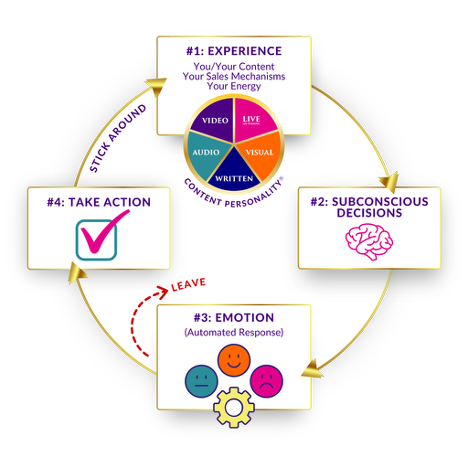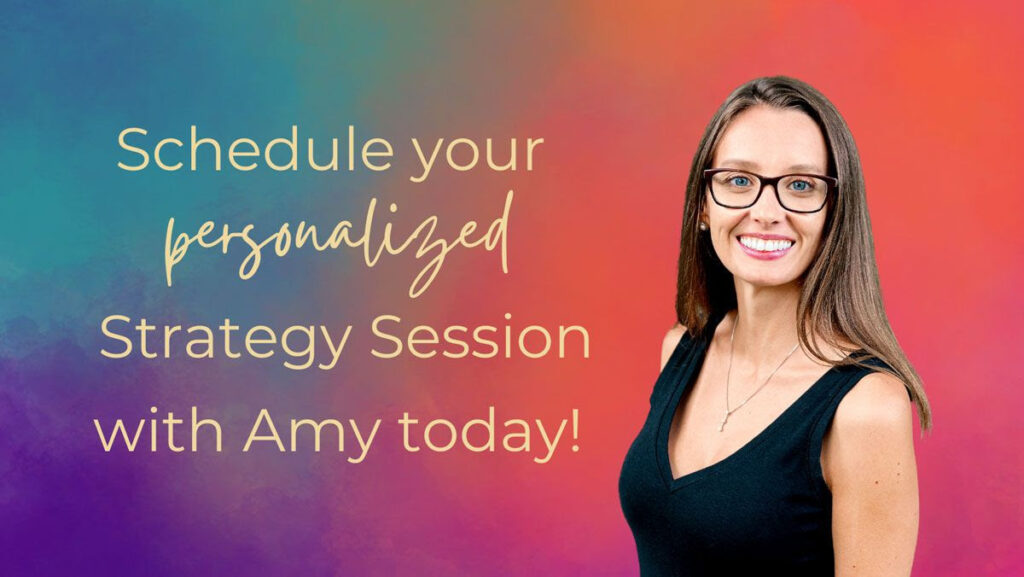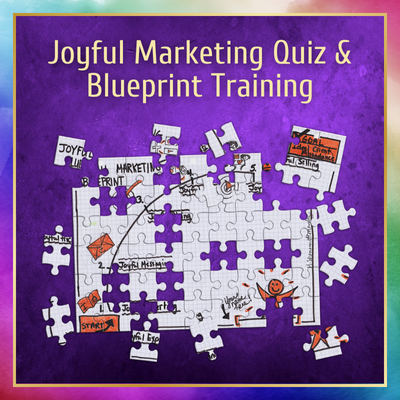Wondering why your no-brainer lead magnets aren’t working? You’re not alone — but there are several things you need to know about your lead magnets, your target audience, and what actually works.
Over the last decade-plus working with coaches, strategists, and other small business owners, I’ve learned a lot about what works…and what doesn’t.
And there are two things I want you to know:
- Most lead magnets are designed for the wrong target audience. They’re quick-hit freebies—it’s easy to get people to download them but they don’t engage your potential client or move them closer to hiring you for a coaching session or longer relationship.
- If your lead magnet isn’t converting, it’s not because your offer isn’t good. It’s because your lead magnet isn’t aligned with a Level 5 Buyer—the person who’s fully aware of their problem and ready to take action within 30 days.
So before we get into tactics and start talking about how to change those no-brainer freebies into something that drives conversions, here’s the big question:
What is your lead magnet really supposed to be doing for you?
Is it just a simple opt-in that’s collecting emails… or are you trying to connect with your perfect-fit dream clients? Is it a giveaway… or a preview of the transformation you offer?
Or is it part of a bigger email marketing strategy designed to deliver actionable insights and convert prospects into coaching clients?
What is a Level Five Buyer?
Before I go any further, I want to make sure you know what I mean when I’m talking about a Level 5 Buyer.
This is the person who is ready to buy from you in the next 30 days.
(Note: It’s almost never the freebie seeker who wants a quick throwaway lead magnet.)
And honestly, these days, not many people even want those — just think how many freebies are collected at the bottom of your downloads folder or archived emails.
So, when I help people design lead magnets for their Level 5 buyer, there’s a lot of messaging psychology that goes into it.
It’s time to determine how you best show up for your audience, tap into their decision-making process and emotions, and guide them to the action that will help them get the results they want.
From there, it’s important to make sure you have a solid nurture and conversion plan!
Here’s one example of how that might break down…
Think of a Level 5 Buyer like this:
- Level 1: They don’t even know your solution exists. They might see gluten-free crackers in the grocery store and think, “Oh, that looks interesting,” and then continue on their path.
- Level 2: They’re aware of a problem but haven’t decided to act. Maybe they have a friend who is gluten intolerant or suspect gluten might be a problem for them, but haven’t confirmed it.
- Level 3: They’re curious and gathering info. They might encounter your gluten-free crackers at a friend’s house and give them a shot.
- Level 4: They’re evaluating solutions. They’re ready to give themselves a break from gluten, but now need to see if your crackers really are the best out there.
- Level 5: They’re ready to buy. They just need to trust that you are the one who can help.
That’s who your lead magnet should be for.
But, the problem for most people lies in understanding who their Level 5 buyers or perfect-fit clients are and what they want—important information if you’re going to create a lead magnet that resonates with them.
Hint: It’s not just “people who have a budget and can afford to pay my rates.”
That Level 5 Buyer has gone through all the stages above—and they don’t need another free guide or basic checklist. They need clarity and to know that your coaching program or offer is the right next step.
Need help figuring out who your Level 5 buyers are and how to reach them? Schedule a call with Amy, and she’ll help you identify your best next steps.
Why Coaches, Consultants, and Experts Need Lead Magnets
There’s no shortage of lead magnets for coaches out there—but most fall flat because they’re not designed with your best-fit clients in mind.
I want you to think of a good lead magnet like the awning outside your storefront—it lets people know you’re here and gives them a reason to walk in.
But the biggest mistake I see is when people see lead magnets as a tool to build your list. That’s just a side benefit.
If you shift your perspective slightly and think of lead magnets as a way to showcase your expertise and connect with the people who are ready to buy, that’s when I see them work the best.
Do you really have a lead generation problem?
I really don’t believe any of us have a lead generation problem—we have a conversion problem. Most coaches I talk to don’t need dozens of leads joining their email list every week. They need qualified leads who are ready to step into a coaching program, membership program, or stand alone offer.
So those LinkedIn messages or cold pitches offering you a dozen calls a week often land flat. There’s a lot I’d rather do than have 87 more calls a month—a lot.
In fact, if that was required in my business, I’d probably be doing something else. I’ll say it again: I don’t believe any of us have a leads problem — we have a conversion problem.
So, when I say you don’t need a tidal wave of opt-ins, I really mean that you just need the right people—your Level 5 buyers—seeing the right thing… at the right time.
And from there, it’s a matter of converting them.
So I want you to design your next lead magnet with your Level 5 buyer in mind, because focusing on the freebie seeker is a waste of time. Freebie seekers are designed for tire kickers, not buyers.
Interested in reenvisioning your lead magnet to connect with people ready to buy from you in the next 30 days?
My 8-week Lead Magnet & Nurture Sequence Creation Intensive is designed to help you develop your lead magnet and build out a sequence that converts your Level 5 buyers. Check it out here.
Every coaching niche is different, and whether you’re a business coach, life coach, leadership coach, executive coach, or health coach— or offer strategic consulting services, the right lead magnet can help you attract your dream clients and convert them into a paying customer.
13 Lead Magnet Ideas for Coaches & Consultants—Why They Work and When to Use Them
There’s no one-size-fits-all lead magnet. I want to reiterate though that as long as you design yours for a Level 5 Buyer, almost any style can work.
Below, I’m sharing 13 of the best lead magnets for coaches, complete with real-world examples and strategy tips so you can build something that works for your business.
Lead Magnet #1: Quizzes
What they are: We’ve all taken online quizzes — and you’ve probably seen everything from “What type of cookie are you?” to “What type of shampoo is best for your hair type?”.
In a nutshell, quiz lead magnets are just assessments that categorize people or diagnose something.
- When they work: Growing your list or gathering data about prospective clients. The deeper the assessment, the more likely you are to attract your Level 5 buyers.
- When they don’t work: I want you to know that quick-hit personality quizzes rarely convert buyers. Something like, “What’s your coaching archetype?” isn’t likely to convert.
- See one in action: My Joyful Marketing Quiz is a great lead magnet example for coaches—it includes a quiz, a short video, and a free blueprint to help turn more leads into buyers.
Lead Magnet #2. Calculators
What they are: Calculators are interactive tools that let your audience plug in numbers to generate a result—like pricing estimates, revenue projections, or even return on investment.
You’ve probably seen these on real estate or marketing sites (think “What’s your home worth?” or “How much should you be charging?”).
- When they work: Calculators are great for raising awareness and helping your audience visualize the gap between where they are and where they want to be. I think they are particularly useful when you speak directly to people and help them calculate results that point them to your services.
- When they don’t work: They rarely convert without a strong nurture sequence or sales follow-up. That said, I don’t want you to throw this out as an idea if you’re comfortable doing those sales — or if you only need a handful of great leads every month to grow the business you want.
Lead Magnet #3. Checklists & Cheat Sheets
What they are: Checklists and cheat sheets are simple, skimmable one-pagers that break down a process, task, or set of must-do actions. They’re designed to be easy to digest and even easier to implement—think “10 Steps to Launch Your Podcast” or “Quickstart Guide to Writing Better Emails.”
- When they work: These can be great for attracting attention if they’re highly specific and tied to a real-time pain point your audience is actively trying to solve. Before you dive in here — think about how you can use it to help the people downloading it get quick wins that push them forward—towards you.
- When they don’t work: If you can Google the info (or ask ChatGPT), it’s a waste of time—and it becomes a throwaway lead magnet. If it’s generic or surface level, these docs don’t build trust—they gather dust in your downloads folder.
Lead Magnet #4. Scorecards & Assessments
What they are: I see scorecards and assessments as structured evaluations that help your audience measure where they are now and what needs to improve to get them where they want to go.
You might also call these audits.
- When they work: I love assessments because they are usually designed with Level 5 buyers in mind —people who already know something’s not working and are actively seeking clarity and next steps.This type of lead magnet example works especially well in industries like health and business coaching, where clients want clear benchmarks and actionable insights. But done right, most small businesses can use them!
- When they don’t work: If it’s too generic or lacks real insight, it’s not great. The last thing you want is for people to say, “well, that wasn’t worth my energy.”
- See one in action: My Business Expansion Scorecard is an example of a quiz that really works. It’s a high-value, Level 5 quiz that helps coaches identify their business bottlenecks and figure out their next steps.

Lead Magnet #5. Mini-Trainings or Video Walkthroughs
What they are: I wouldn’t call these short-form content, per se, because I think of short-form content like social media posts or TikTok videos. However, these are usually short videos that explain a concept, method, or framework. I often use them in terms of single Loom recording or a 3-part email series that gives your audience a taste of how you work—and how you think.
- When they work: I love these because videos are a great way for people to get an idea of your personality and what it’s like to work with you. When you’re able to pair them with a clear message and structured follow-up, they’re a great way to connect with Level 5 buyers.These are particularly effective in email list building—especially if they lead into an email course or support a launch sequence for your coaching program or offer.
- When they don’t work: I feel strongly that video is a great way to show up, but it doesn’t work if you hate showing up on video. To that end, it also doesn’t work if you don’t have a clear path for what action they should take after seeing the video. If you’re going to the effort of creating a video, make sure to tie next steps into your lead generation workflows.
- See one in action: My “Sales Page Help is Here” bingeable video email series is a perfect example. It’s short, strategic, and walks people through the invisible forces behind what makes messaging stick. It builds value and interest—without giving away the whole store.
Lead Magnet #6. Custom GPTs
What they are: Full disclosure — I have never used these as lead magnets. However, I’m seeing more buzz about Custom GPTs so I want to address them. These are AI-powered tools that perform specific tasks—like writing LinkedIn hooks, building outlines, or analyzing content. They’re interactive, branded, and often incredibly sticky when designed well.
- When they work: When your GPT solves a clear problem or speeds up a tedious task, it becomes a tool your audience wants to keep coming back to. Think of it like a smart calculator or strategic quiz—built for utility, not just novelty. And, when they can highlight the value you bring, even better.
- When they don’t work: If your GPT replaces a service you actually offer—or gives away too much—you’re undercutting yourself. And if it’s too general, it won’t feel unique or worth bookmarking.
Lead Magnet #7. eBooks
What they are: eBooks are long-form PDF downloads that explore a topic in more depth.
- When they work: They can work well for larger brands or audiences already familiar with your work.
- When they don’t work: I have not seen them work well for most coaches, consultants, or small teams. They take a lot of time and energy to create, are easy to ignore, and rarely lead to real conversations.
Lead Magnet #8. Live Trainings
What they are: Real-time virtual workshops, classes, or sessions. As lead magnets, they’re usually free or low-cost. That said, if you can promise a great outcome, you can certainly charge even more.
- When they work: I love showing up live and I’ve found them especially fantastic for those of us who thrive in real-time interaction. Like videos, they give people a sense of who you are and what it’s like to work with you.I think they’re even better with a small fee—e.g. $47—because these are qualified leads that lead to high conversion rates! You’ll see fewer sign-ups, but even that small cost means people have more skin in the game to show up and do the work.When I switched from free trainings that got hundreds of signups (but few conversions), to $47 for workshops, I get a smaller more intimate group—and most people decide to work with us.
- When they don’t work: There are plenty of times when they don’t work to convert:
- If you give away the entire answer for free, they don’t need to work with you.
- Free sign-ups don’t guarantee engagement
- If you don’t have a strategic follow-up or conversion path.
Lead Magnet #9. Pre-Recorded Webinars & Workshops
What they are: Pre-recorded webinars are on-demand video trainings your audience can watch at their convenience. I’ve seen people host them on their own sites, through email funnels, or even share them at specific times of the year.
- When they work: They work best when you advertise that they’re pre-recorded and have strong follow-up automations or processes.
- When they don’t work: It may seem like a no-brainer to market them as pre-recorded, but some people pitch these as live and it feels really disingenuous. And, if you don’t thrive in front of a camera with no audience — they might not be a good fit. So the solution would be to lean into live delivery and then share the recording. I’d encourage you to stay away from evergreen funnels if they don’t reflect your strengths.
- See one in action: I have a series of videos that are a great example of using a pre-recorded webinar as a lead magnet. You can check out my 4 Step Organic Marketing Plan here. It works well because each video is a short snapshot of each step. The first video can be watched as a teaser, and then to get the rest of the plan people need to opt in.
Lead Magnet #10. Swipe Files & Resource Libraries
What they are: I think these are pretty self-explanatory, but in a nutshell, these are usually curated bundles of templates, swipe copy, or tools.
- When they work: If the bundle is useful, saves time for your audience, and ties directly to your paid offer, it can be incredibly effective. If it replaces you, then not so much.
- When they don’t work: If it’s a random collection of assets with no strategic thread, it becomes a Pinterest board — interesting, but not really all that helpful. And if they don’t clearly connect to what you sell, people won’t see a reason to take the next step—whatever it is.Also, my biggest caution with swipe files and templates is that messaging is usually so specific to your audience, that there’s a good chance it might not resonate with your audience’s perfect-fit clients — so it might not work for them which may counteract any trust you’re building.
Lead Magnet #11. Short Challenges (3-Day, 5-Day, etc)
What they are: You’ve seen these all over the place — short “programs” where people tackle a problem one small “bite” at a time. They build momentum, create small wins with accountability baked in, and give participants a sense of what it’s like to work with you.
- When they work: I’ve seen challenges work really well and I’ve seen them fall flat. The best way to tailor your challenge to a Level 5 buyer is to figure out where they are now and where they want to go— and then where you come in.
So if you can use the challenge as a way to prepare them to become great clients, tying each day directly to your offer, and wrapping with a strong CTA and incentive — well, I’d say a challenge could work well for you. - When they don’t work: If the challenge overwhelms people or feels disjointed, you risk losing them before the end. And if there’s no clear next step once the challenge ends, you’ve built excitement with nowhere to go.
Lead Magnet #12. Free consultation
What they are: I want to be very clear that I do not consider these to be lead magnets — these are opportunities for your audience to get on the phone with you. And how you frame them matters— but free consultations, whatever you call them—are 1:1 calls where you can talk about goals, struggles, or if you’re the right fit.
- When they work: I think these free sessions work really well when you have a pre-qualification process in place—and when you position them as strategic sessions. When the person shows up knowing what you do and is already interested in getting support, the conversation moves quickly and meaningfully toward a decision.
- When they don’t work: If you’re offering open calls with no filters, you’ll spend a lot of time talking to people who aren’t a fit—and have no intention of buying. That’s draining, inefficient, and creates zero momentum.
- See them in action: I strongly believe that if someone is considering working with you, they deserve a chance to ask you questions ahead of time. So we always offer 20-minute growth strategy sessions to help people see what it’s like to work with us. But they don’t get access to our schedule without sharing quite a bit of information to help us understand where they are and make the most of their time.
Lead Magnet #13. Office Hours
What they are: I absolutely love offering office hours as a lead magnet. It ties right into my love of showing up live without the formality of a workshop or training. We treat office hours are live, small-group sessions where people can show up, ask questions, and get answers as well as a taste of what it’s like to work with us.
- When they work: I firmly believe that office hours are a fantastic way to build credibility and highlight what you know. However, I’d caution you to use a short pre-qualifiying question step and limit the number of people who can come. Doing so ensures that people show up ready to engage and solve problems and sets up the session as valuable.
- When they don’t work: If you open the doors to everyone without any context or structure, it can feel messy—or like free coaching with no path for conventions. I encourage you to be sure there’s a clear container and a reason for them to take the next step.
- See it in action: I offer office hours every month as a way to let people ask me anything. It feels good to give back while also showing how we can help. You can see how I do it here. Additionally, if you have a question about anything — say lead magnets, for example, feel free to snag a slot!

Promoting Your Lead Magnets
Once you have a great lead magnet (because I know it will be great when you create it with your Level 5 buyer in mind), the real fun begins—marketing.
Creating the lead magnet is only the start. Now it’s time to make sure you have a path to conversion and get it into the hands of the right prospects.
Effective lead generation isn’t about shouting into the void—or at people. It’s about growing meaningful relationships with your ideal clients.
So the first step, before you ever launch it, is to get your automations and nurture sequence in place.
I recommend:
- Building a simple landing page with compelling messaging that speaks to your perfect-fit clients
- Creating notification emails so you know when people download it.
- Map out a nurture that highlights what your Level 5 buyers need to know.
- Including a case study and testimonials.
- Programming it all into your email marketing platform (here’s a breakdown of the best systems for coaches and consultants)
- Have a plan to follow up with people
Now it’s time to direct traffic to your landing page so people sign up! Here are a few strategies that I’ve successfully used to get my lead magnets in front of Level 5 buyers:
- Do a live launch event with a quick 20-minute how-to use it training.
- Invite people to grab it every time you speak in person, online, or on a podcast.
- Include a link in your email signature.
- Try a lead magnet swap with someone with a similar audience.
- Embed it in your blog posts.
- Share it in social posts regularly.
- Share it with your email community — yes they’re already in your ecosystem, but it might be what people need to take the next step
Looking for more out-of-the-box marketing ideas? Check out my recent article, It’s 2025. It’s Time to Start Marketing Without Social Media.
Ready to Create a Lead Magnet That Actually Converts?
You don’t need another throwaway freebie, and you definitely don’t need 35 leads a day. My guess is what you really need is a path to connect with your Level 5 buyers and grow those relationships so they come to you when they’re ready.
And if you’re using a lead magnet to do that, you’ve got to make sure it’s something that serves their needs and yours.
So, if you’re tired of growing lists that don’t lead to sales, it’s time to shift your strategy.
If you’re stumped, need an outside perspective, or want someone to tackle it for you, we’d love to show you how we can help.
Check out our DIY, Group, and 1:1 programs here — or schedule a quick call to find out what the best step is based on where you are right now.





